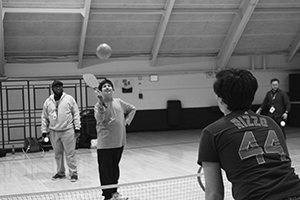Adaptive PE shares similarities, should offer credit incentives

Photo by Sheila Fogarty
Paddle Pals: Returning a serve, junior Parsa Mir Heydari plays pickle ball with Eddie Brown, adaptive PE Leader. Adaptive PE leaders share similar responsibilities as other PE leaders.
March 14, 2019
This marks my third semester being a peer mentor or P.E. Leader for an a Adapted P.E. (APE) class, a course modified for a variety of students based on their abilities. It’s taught by Tori Kelliher and is composed of peer mentors, aides and participating students. The class in which I am currently a P.E. Leader has 12 students and three peer mentors, falling short from an ideal ratio of two mentors per student, according to Kelliher.
“Not only does [having peer mentors] give the students in the class somebody to look up to for how they should be completing an exercise, but it also gives them the opportunity to see the invisible culture of the school,” Kelliher said.
When I first realized peer mentors in P.E. classes didn’t receive P.E. credits, I was surprised. Mentors are held to equivalent standards as are P.E. Leaders— they prepare equipment, help with attendance, dress in their P.E. uniforms, lead the kids in activities or exercises and help students one-on-one. Mentors even put in a comparable amount of physical effort to that of a P.E. Leader.
To more accurately highlight that the physical effort required for being an APE mentor is comparable to being a P.E. leader, I tracked the heart rates of two peer mentors, myself and two P.E. Leaders. The heart rate monitors placed students in a specific “zone” based upon their heart rate, ranging from very light, light, moderate, hard and maximum. According to Kelliher, P.E. instructors aim for their students to spend time in the moderate and hard zones while occasionally peaking in the maximum zone.
“Kids are doing similar amount of work being in a gen- ed. class comparatively to being in an adapted P.E. class in [terms of] cardiovascular fitness,” Kelliher said. “When looking at the heart rate zones that my peer mentors completed, they spent most of their time in a moderate to hard zone, which [meets P.E. expectations].”
The data shows that the work of senior P.E. Leaders and peer mentors is comparable in cardiovascular fitness in addition to their expectations and duties. Peer mentors are expected to participate alongside students and lead by example in each activity, creating a balance between leadership and physical exercise during the class.
Putting the evidence of active participation aside, peer mentoring an APE class is an important role that is integral in promoting inclusivity at GBS. Being a mentor in APE means forming relationships that extend beyond a senior-underclassman relationship. When I walk through the halls and hear one of my APE peers call out “SheilaSheilaaaaaa”, I’m reminded of this unique friendship dynamic — a direct representation of APE’s inclusive culture spreading outside of P.E. class. I strongly believe that if P.E. credit was offered for mentors, this would be a more widely experienced phenomenon and create an even healthier and more welcoming atmosphere within the halls of GBS and in P.E. programs.


